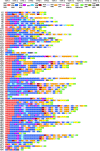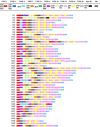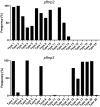Genetic variations in histidine-rich protein 2 and histidine-rich protein 3 of Myanmar Plasmodium falciparum isolates
- PMID: 33138831
- PMCID: PMC7607715
- DOI: 10.1186/s12936-020-03456-6
Genetic variations in histidine-rich protein 2 and histidine-rich protein 3 of Myanmar Plasmodium falciparum isolates
Abstract
Background: Malaria rapid diagnostic tests (RDTs) are precious tools to diagnose malaria. Most RDTs used currently are based on the detection of Plasmodium falciparum histidine-rich protein 2 (PfHRP2) in a patient's blood. However, concern has been raised in recent years that deletion of pfhrp2 in the parasite could affect the accuracy of PfHRP2-based RDTs. In addition, genetic variation in pfhrp2 might influence the accuracy and sensitivity of RDTs. In this study, the genetic variation in pfhrp2 and pfhrp3 in Myanmar P. falciparum isolates was analysed.
Methods: Blood samples were collected from malaria patients who were infected with P. falciparum in Mandalay, Naung Cho, Tha Beik Kyin, and Pyin Oo Lwin, Upper Myanmar between 2013 and 2015. The pfhrp2 and pfhrp3 were amplified by nested polymerase chain reaction (PCR), cloned and sequenced. Genetic variation in Myanmar pfhrp2 and pfhrp3 was analysed using the DNASTAR program. Comparative analysis of Myanmar and global pfhrp2 and pfhrp3 isolates was also performed.
Results: One-hundred and two pfhrp2 and 89 pfhrp3 were amplified from 105 blood samples, of which 84 pfhrp2 and 56 pfhrp3 sequences were obtained successfully. Myanmar pfhrp2 and pfhrp3 showed high levels of genetic variation with different arrangements of distinct repeat types, which further classified Myanmar pfhrp2 and pfhrp3 into 76 and 47 haplotypes, respectively. Novel amino acid changes were also found in Myanmar pfhrp2 and pfhrp3, but their frequencies were very low. Similar structural organization was shared by Myanmar and global pfhrp2 and pfhrp3, and differences in frequencies of repeat types and lengths were also observed between and among global isolates.
Conclusion: Length polymorphisms and amino acid substitutions generated extensive genetic variation in Myanmar pfhrp2 and pfhrp3. Comparative analysis revealed that global pfhrp2 and pfhrp3 share similar structural features, as well as extensive length polymorphisms and distinct organizations of repeat types. These results provide a better understanding of the genetic structure of pfhrp2 and pfhrp3 in global P. falciparum populations and suggest useful information to develop RDTs with improved quality.
Keywords: Genetic polymorphism; Histidine-rich protein 2; Histidine-rich protein 3; Myanmar; Plasmodium falciparum.
Conflict of interest statement
The authors declare that they have no competing interests.
Figures




References
-
- WHO . World malaria report 2018. Geneva: World Health Organization; 2018.
-
- WHO . Malaria rapid diagnostic test performance: summary results of WHO product testing of malaria RDTs: rounds 1–6 (2008–2015) Geneva: World Health Organization; 2016.
MeSH terms
Substances
Grants and funding
LinkOut - more resources
Full Text Sources

